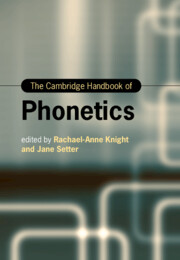Book contents
- The Cambridge Handbook of Phonetics
- Cambridge Handbooks in Language and Linguistics
- The Cambridge Handbook of Phonetics
- Copyright page
- Contents
- Figures
- Tables
- Contributors
- Introduction
- Section I Segmental Production
- Section II Prosodic Production
- Section III Measuring Speech
- Section IV Audition and Perception
- 16 Neurological Foundations of Phonetic Sciences
- 17 Psycholinguistic Aspects
- 18 Phonetics and Eye-Tracking
- 19 Automatic Speech Recognition by Machines
- Section V Applications of Phonetics
- Index
- References
17 - Psycholinguistic Aspects
from Section IV - Audition and Perception
Published online by Cambridge University Press: 11 November 2021
- The Cambridge Handbook of Phonetics
- Cambridge Handbooks in Language and Linguistics
- The Cambridge Handbook of Phonetics
- Copyright page
- Contents
- Figures
- Tables
- Contributors
- Introduction
- Section I Segmental Production
- Section II Prosodic Production
- Section III Measuring Speech
- Section IV Audition and Perception
- 16 Neurological Foundations of Phonetic Sciences
- 17 Psycholinguistic Aspects
- 18 Phonetics and Eye-Tracking
- 19 Automatic Speech Recognition by Machines
- Section V Applications of Phonetics
- Index
- References
Summary
This chapter provides an overview of research that combines phonetics and psycholinguistics. It underscores a number of papers that highlight a story about the history, issues and trends in the field. In doing so, papers that can serve as good pointers to different subfields are examined. The chapter oscillates between foundational work and more recent work, hoping that it can provide a broad introduction to this area of research. This chapter particularly focuses on issues that merge phonetic variation, spoken word recognition, memory, and sociolinguistics. Research in this area has not only raised questions about the assumptions made about how listeners understand spoken language, but is also ripe for investigations that have a broad impact across psychology and linguistics more generally.
Keywords
- Type
- Chapter
- Information
- The Cambridge Handbook of Phonetics , pp. 430 - 456Publisher: Cambridge University PressPrint publication year: 2021

